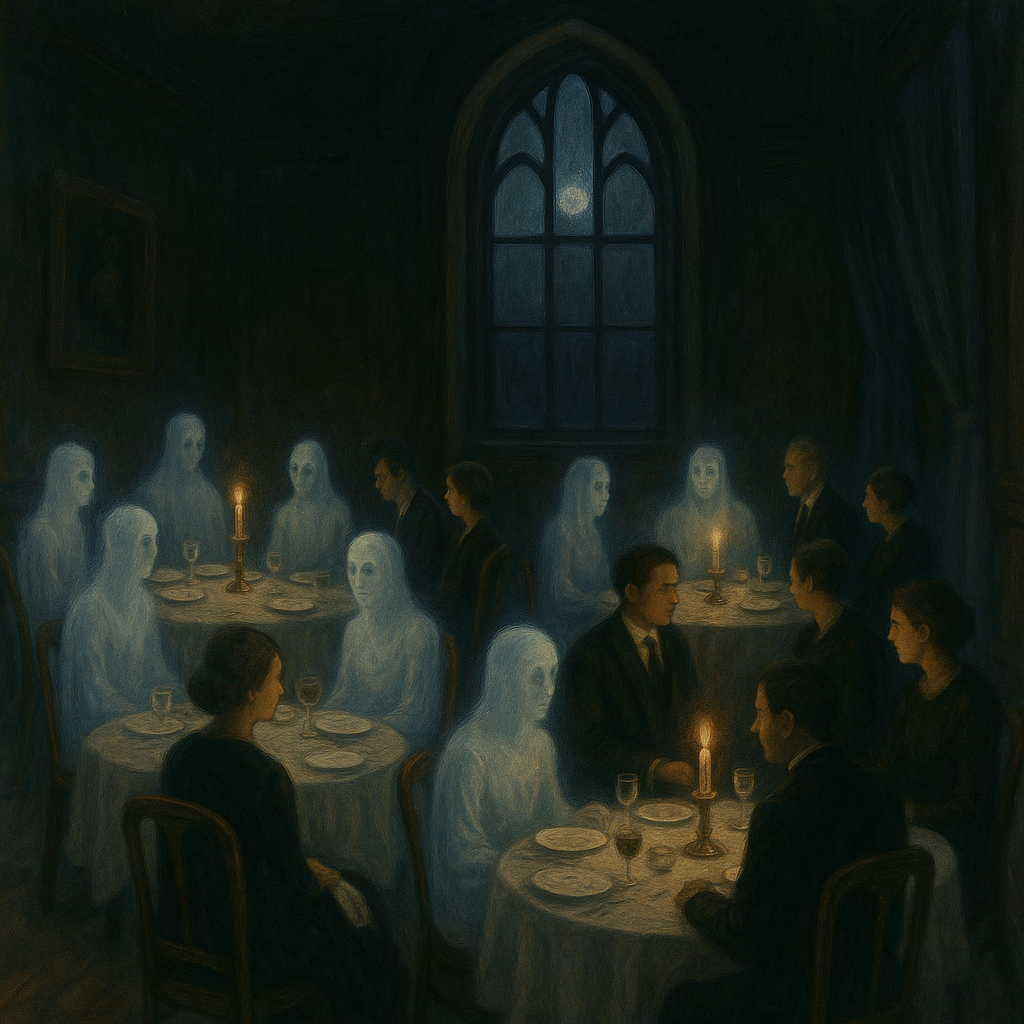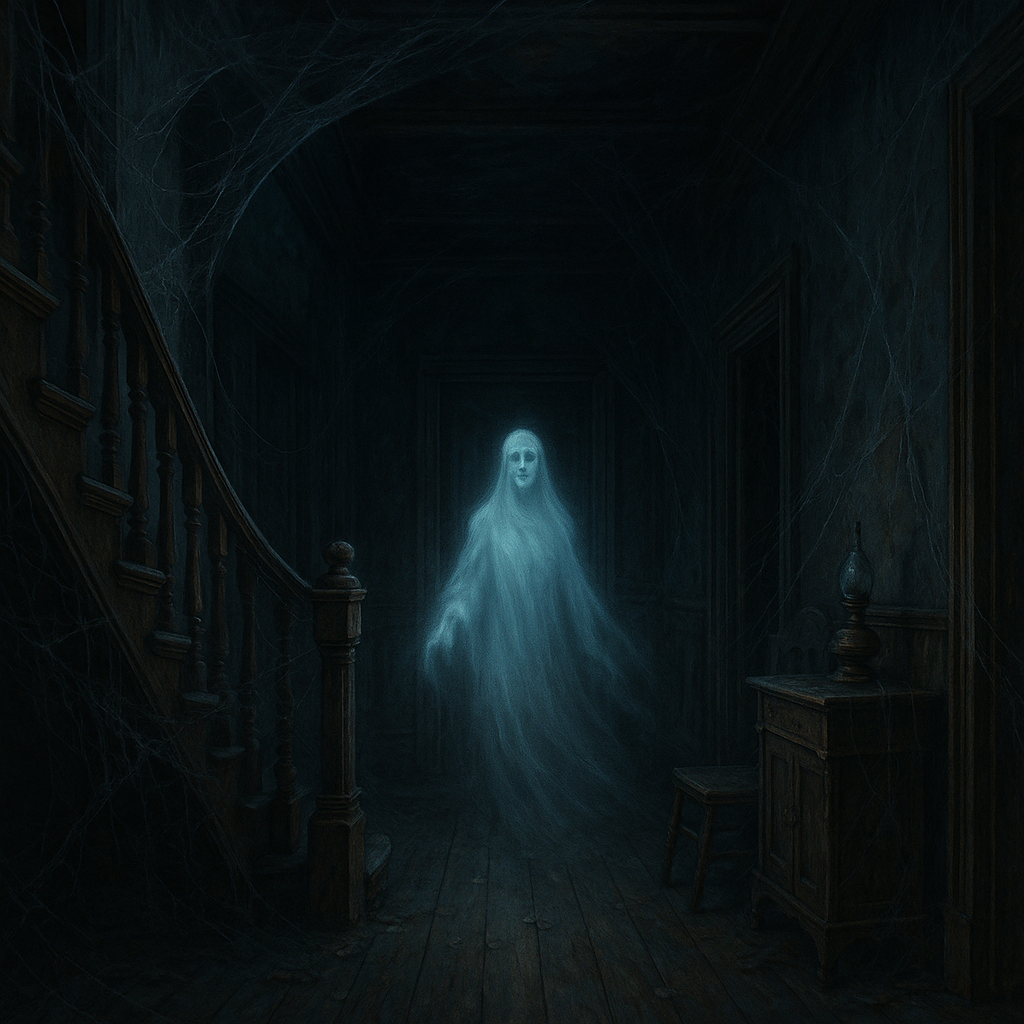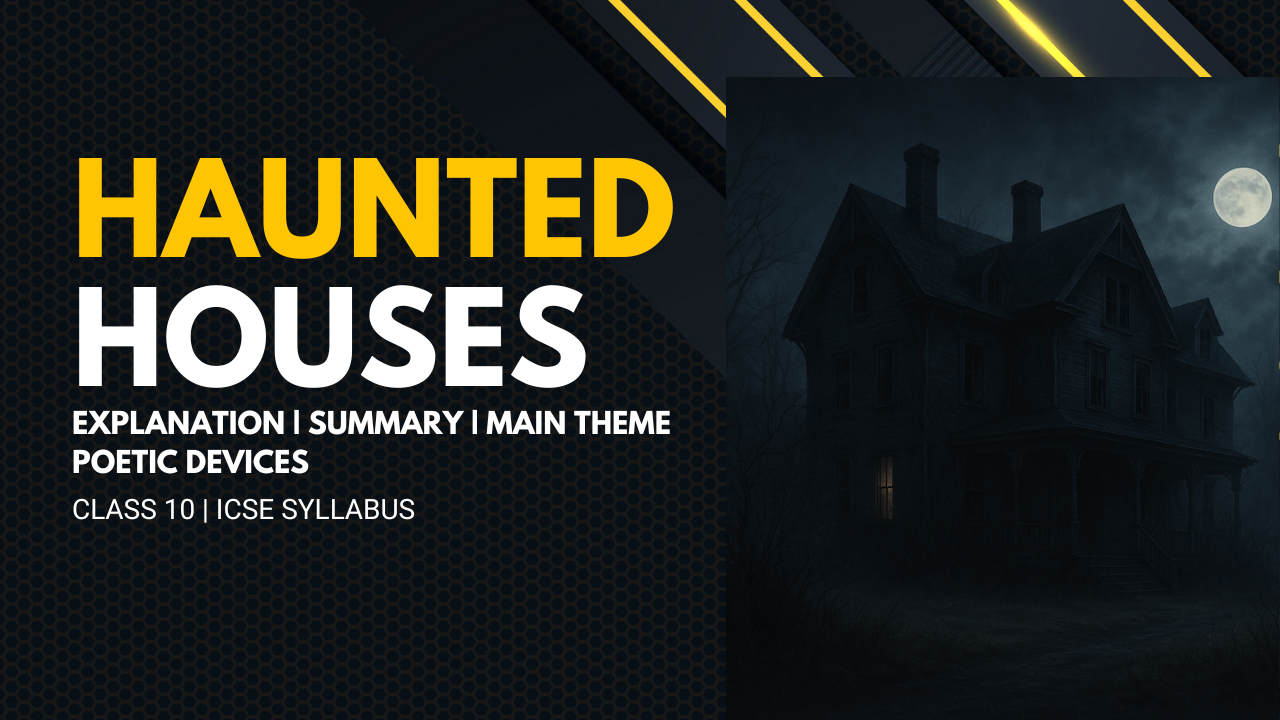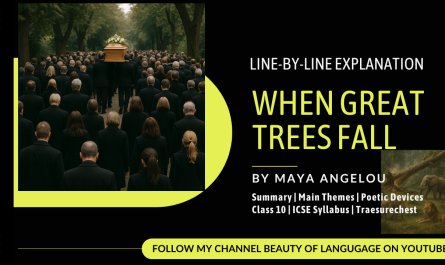Explanation | Summary | Poetic Devices | Main Theme | Class 10 ICSE Syllabus | Treasure Chest
Short Summary of the poem
In Haunted Houses, the poet H.W. Longfellow says every home has its own past — and its own ghosts. Not scary ghosts — but harmless spirits of people who once lived, loved, and died there. These phantoms quietly glide through open doors, run little errands, and leave behind a faint, unspoken presence — felt in the air, but never seen or heard.
They’re everywhere — at doorways, on staircases, in passages — just silently moving to and fro, connected to the house through memories and love.
At parties, there seem to be more people at the table than invited. Why? Because the dead are still there — quiet, invisible, silent like the paintings on the wall. They don’t interfere, they don’t speak — but they’re present.

Then in the 4th stanza, the narrator says that he can see the ghosts, but the stranger sitting next to him can’t. Which means either he has super-natural power or he is one of them.
This is further clear in the 5th stanza, which starts with the pronoun WE. These ghosts may not have the title-deeds to prove their ownership — but emotionally, they never let go. Even if these phantoms are forgotten, their dusty hands still reach out from the grave, holding on to their old homes and unwilling to let go.
The poem then moves deeper — saying the ghost world isn’t far away. It’s wrapped around our living world like a layer of atmosphere. We can’t touch it, but it’s always around us — floating like mist.
Then Longfellow shifts focus. He says human life is a balance between attraction and aspiration — between things we want for pleasure and dreams we for which we work hard. That struggle gives our lives meaning.
And finally, the moonlight. It becomes a magical “bridge of light” between the living and the spirit world. At night, this bridge lets our thoughts and dreams wander into mystery — guiding our desires and actions in the daytime.
So in the end, Haunted Houses isn’t a horror poem. It’s about memory, presence, and how the past — even the people we’ve lost—still lives quietly around us.
Main Themes of the Poem
1. Memory and the past– The poem suggests that houses become haunted by the memories of people who lived there in the house and died there itself. Now these memories, what do they do? They linger ghosts creating a sense of the past in the present.
2. Inevitability of Death– Through the poem, the poet tells us that the people who once lived there in the houses passed away, making the house “The Haunted House”. So death is inevitable; it cannot be escaped!
3. Power that a Place holds– The poem tells us that the place, the haunted house, holds the essence of those who lived there. Even though they are no more, but their presence is still felt. And this particular thing creates a connection between the physical space and the people who lived there.
4. Nature of Ghosts – As I already mentioned that the poet in this poem has portrayed the ghosts on a very light note. The ghosts have been perceived as completely harmless, they just glide through the corridors in the house. They sit in the illuminated hall, as silent as pictures on the wall.
5. The Duality of human nature– In this poem, the poet has also discussed about the squabble, or the scuffle between the physical desires of a person and the spiritual aspirations of a human being. And these feelings balance a human life.
Poetic Devices used in the Poem
1. Metaphor: It is the poetic device used where comparison is made without using “like” or “as”.
In the 9th stanza, the bridge of moonlight from the sky down to the sea is like the mysterious bridge that connects the spirit world to the human world.
2. Simile: It is a direct comparison between two similar things or objects, using like or as. In this poem, the poet has compared the inoffensive ghosts as silent as the pictures on the wall in stanza 3 :
“Is thronged with quiet, inoffensive ghosts,
As silent as the pictures on the wall”
3. Alliteration: The poetic device where there is repetition of consonant sounds. You can find Alliteration in the lines like-
- ‘m’ and ‘p’ sounds in the line- Impalpable impressions on the air
- ‘s’ sound in the line- A sense of something moving to and fro
- ‘d’ and ‘h’ sounds in the line- All houses wherein men have lived and died, Are haunted houses.
4. Personification: The poetic device where human attributes are given to a non-living thing. It is used, in Stanza 9 where ‘the moon’ has been personified as a heavenly being :
“And as the moon from some dark gate of cloud
Throws o’er the sea a floating bridge of light.”
About the poet
The poet, Henry Wadsworth Longfellow, was a much-celebrated 19th-century American poet. His writings, whether lyrical, narrative, or descriptive they were written in a natural and traditional style, and this reminded Americans of their roots, that is, where they came from, their origin.
Longfellow was lovingly regarded as a fireside poet. Because it is said that his works were meant to be read out as a form of entertainment for family and friends sitting by a fireplace, he was a leading member of the Fireside Poets, a 19th-century American literary group which included other great poets like William Cullen Bryant, John Greenleaf Whittier, Oliver Wendell Holmes, and James Russell Lowell.
His famous works are “A Psalm of Life”, “Excelsior”, “Nature”, etc. And these poems highlight the qualities of compassion, tranquility, and didacticism, which means to teach people something, especially a moral lesson.
About The Poem
In this poem, Haunted Houses, H.W.Longfellow dispels this traditional spookiness of ghosts and presents them in a very gentle light. His ghosts and phantoms are inoffensive and harmless. They merely float through doorways and halls. And these ghosts are as silent as paintings on the wall.
There is a sense of comfort and familiarity in Longfellow’s ghosts in this poem because it starts with a very assertive statement that all houses where men have lived and died are haunted. Mine, yours, and even your neighbor’s house is haunted, but these hauntings are not terrifying or evil. In fact these are just the lingering memories of our departed dear ones. The poem, therefore, explores nostalgia, the passage of time, and the enduring power of memories.
The rhyme scheme of the poem is ABAB.
Line-by-Line Explanation of the poem
Stanza 1
All houses wherein men have lived and died
Are haunted houses. Through the open doors
The harmless phantoms on their errands glide,
With feet that make no sound upon the floors.
Word-meanings:
Phantoms- ghosts
Errands- short journey to collect or deliver something
Glide- to move smoothly
Explanation:
The poet starts the poem by telling that whichever house men live in has a history. And in whichever houses men lived, they are now dead and have become Haunted Houses. These men about whom the poet is telling are the people who have touched our lives in a certain way, with whom we have encountered at a certain point in our lives.
These ghosts, they glide through the open doors. And since they are ghosts so this line suggests that they can pass through anything. This quality of the ghosts presents their ETHEREAL NATURE. And in these lines the poet has mentioned the ghosts as “Harmless phantoms”.
Generally, whenever we hear the term ghosts, it generates the feeling of spookiness or we think of them as dangerous. But here they are completely harmless and are just gliding through the doors to run some errands. And while they glide, they don’t make any sound with their feet on the floor, unlike the human beings.

Stanza 2
We meet them at the door way, on the stair,
Along the passages they come and go,
Impalpable impressions on the air,
A sense of something moving to and fro.
Word-meanings:
Passages- narrow way allowing access between different rooms within a building
Impalpable- cannot be felt by touch
Explanation-
In this paragraph, the poet says that these phantoms, these ghosts, are everywhere. It is not that they are confined to a particular place. We can meet them at the doorway, we can meet them at the stairs, or along the passage. And what do they do at all these places? They just come and go.
Nex, Impalpable impressions on the air means these phantoms are intangible, imperceptible, they cannot be touched by bare hands, they cannot be seen. So they are no physical beings. They only have impressions left in the air.
Then, A sense of something moving to and fro shows a very delicate nature of these ghosts. The poet here is not telling what that something is. But yes, there is something that is moving to and fro. So you might not be able to see them, but yes, definitely sense them! People are always connected to their loved ones, so these connections might keep them attached to the places where these ghosts are moving. So it’s the bond, and that is the reason why they are always around us.
Stanza 3
There are more guests at table than the hosts
Invited; the illuminated hall
Is thronged with quiet, inoffensive ghosts,
As silent as the pictures on the wall.
Word-meanings:
Illuminated hall- well lit hall
Thronged- crowded
Inoffensive- harmless
Explanation-
In this stanza, the poet is saying that- There are more guests at table than the host has invited. So now you know who those extra guests are? Those extra guests are these phantoms, who are there in the hall, uninvited. This shows their presence in the house, even though they cannot be seen. They are co-existing, the living and the dead are together.
The illuminated hall, here, means that the hall where all the guests are sitting is well lit. Completely illuminated. So the hall is illuminated and is crowded with quiet and inoffensive ghosts. These ghosts are quiet and completely harmless.
They are as silent as the pictures on the wall. They are just present there. Not interrupting, not harming, but yes, they are just there, silently observing the living people, who can be their children or grandchildren. In this line the poet has used- Simile, where comparison is done explicitly, clearly, using as. Here, the ghosts are compared with the pictures on the wall.
Stanza 4
The stranger at my fireside cannot see
The forms I see, nor hear the sounds I hear;
He but perceives what is; while unto me
All that has been is visible and clear.
Word-meanings:
Perceive- becone aware or conscious of
Explanation-
Here the word “stranger” is referred to the visitor. So the poet says that this visitor, who is sitting by the fireside, cannot see the forms, the ghosts, that the narrator of the poem sees. And also, he cannot hear the sounds that he hears. “He”, that is, the visitor, can only perceive, can only notice, or can only realize the things that are visible around, the tangible ones. The stranger can see the guests who are invited, but cannot see the uninvited guests. But then the narrator can see everything, everything that is visible, that is, he can see the living and the dead.
Here, the poet has shown the difference, the past and the present, by using the word “is” in the line, He but perceives what is. Which means the stranger can see the present. But the narrator has seen the past also when he says- All that “has been” is visible and clear- the previous inhabitants of the place and the people who are there in the hall. Now the narrator here can have this supernatural power to see the dead, or he might also be the one among the dead. He can also be one of the ghosts in the house.
Stanza 5
We have no title-deeds to house or lands;
Owners and occupants of earlier dates
From graves forgotten stretch their dusty hands,
And hold in mortmain still their old estates.
Word-meaning:
Title-deeds- legal document of the proof of the ownership
Occupants- the ones living there
Mortmain- the property cannot be transferred or sold to anyone
Explanation:
This stanza starts with the word “WE“. Now, from this we understand that the narrator I from the previous stanza is also one of the ghosts. So he is referring to his people as WE. Here it is said that they, that is, the ghosts, the harmless phantoms who are freely moving around in the house, have no title deeds. So even though they are the ones who lived in that house. But still they don’t have the proof that the property is actually theirs because they are no more.
The next line- Owners and occupants of earlier dates, means that they are the past occupants of that house. They used to live there earlier. From graves forgotten stretch their dusty hands, here the poet has used imagery, you can form a visual in your mind that a hand is coming out from the grave that is smudged with soil and mud. So the narrator says that they stretch their dusty hands from the graves that are now forgotten. People don’t visit them, they don’t offer flowers on their graves.
And hold in mortmain still their old estates. Mortmain is a legal term. So even though the ghosts who were previous inhabitants of that particular place, of that particular house, don’t have the title-deed, but they still hold on to the essence of the ownership of their old estates. That property is like mortmain, that is, the property cannot be sold or it cannot be tranferred to anyone else.
So basically the narrator here expresses that even though they are not the legal owners of that house, but since they used to live there, so they have an attachment to it. And that might be the reason why they are still moving around in the house. They are sitting with the invited guests, and the poet quotes them as “uninvited”.
Stanza 6
The spirit-world around this world of sense
Floats like an atmosphere, and everywhere
Wafts through these earthly mists and vapours dense
A vital breath of more ethereal air.
Word-meaning:
Wafts- gentle breeze
Ethereal- extremely delicate and light
Explanation-
“The spirit-world around this world of sense”, in this line the poet has used the word “world” two times. Spirit-world, refers to the world of the spirits, the ghosts. It represents the space of the dead people. It is the world that cannot be percieved by the living. Remember the word we had used “impalpable” in the second stanza. So the spirit world is that. And then the “world of sense” means the real world, the world of the living, the world which we can perceive with our senses. Here, the poet has written the lines in such a way as to show that these two worlds co-exist.
The next line- Floats like an atmosphere, and everywhere, so here the poet is talking about the spirit world that floats like an atmosphere. It is not visible, we can’t touch it, but, it is there. And it is everywhere. Just like atmosphere surrounds us, in the same way the spirit world is around us. Here again, the poet has used Simile. Because he has compared the world of ghosts with the atmosphere using the word “like”.
Wafts through these earthly mists and vapours dense– Wafts here means to move, or make something move, gently through the air. So these ghosts pass gently through the earthly mists and dense vapours. A vital breath of more ethereal air- here the poet portrays the spiritual world as the vital breath of more ethereal air. Ethereal means extremely delicate and light air, which can only be possible in the spiritual world.
Stanza 7
Our little lives are kept in equipoise
By opposite attractions and desires;
The struggle of the instinct that enjoys,
And the more noble instinct that aspires.
Word-meaning:
Equipoise- balance
Noble- virtuous
Instinct- response to a stimuli
Explanation:
The first line- Our little lives are kept in equipoise, here the poet is talking about the balance that is achieved by the opposite forces. The poet has used the word little lives because he is trying to show the temporary nature of life. So “our little lives” are pulled by different forces.
At one moment you want this, at another moment you want that. But somehow that equilibrium is maintained. And that balance is maintained by things we are attracted to and the desires we have. Here we can consider attraction as a negative connotation, and desire as something positive. As humans, we have this primal instinct to desire. To desire something.
Now the next two lines- The struggle of the instinct that enjoys, And the more noble instinct that aspires. It further explains the two opposite forces that create equilibrium. People who have these instincts for materialistic desires, will enjoy them. But the people with even nobler instincts, they will aspire to become somebody great in their lives.
Here, the poet is acknowledging the importance of being human. And this is the particular thing that distinguishes human being. So each one of us should have this desire to achieve something great in life instead of getting tempted by the attractions.
Stanza 8
These perturbations, this perpetual jar
Of earthly wants and aspirations high,
Come from the influence of an unseen star,
An undiscovered planet in our sky.
Word-meaning:
Perturbations- disturbances
Perpetual- forever
Influence- effect
Undiscovered- not discovered yet
Explnation:
So These perturbations, means mental disturbances, mental uneasiness because of this constant conflict between the attractions and desires.
This perpetual jar, perpetual means forever, never-ending. The poet says that this jar of materialistic desires is never-ending. It is always overflowing. There is always something or the other that we want. These earthly wants and high aspirations, where do they come from? They come from the influence of an unseen star.
According to the poet, all these wants we have, the desire to be rich, the desire to own a luxury car, the desire to be successful, all these come because we are under the influence of an unseen star, some celestial body which has never been seen by anyone. Or it can be a planet that has never been discovered in the sky.
Stanza 9
And as the moon from some dark gate of cloud
Throws o’er the sea a floating bridge of light,
Across whose trembling planks our fancies crowd
Into the realm of mystery and night,-
Word-meanings:
o’er- over
Trembling- shaking
Planks- flat pieces of wood
Fancies- imaginations
Realm- region
Explanation-
In this paragraph, the poet has used beautiful imagery. He says that the moon, as it shines from above the cloud, and that light is thrown over the sea, it forms a bridge of light. The moon is creating a kind of magical path. So the moonlight is acting like a floating bridge of light when it touches the sea. So floating because the moonlight is being cast on the sea. And you know that the sea waves are never stable, they keep on moving and flowing, so the light also, as it falls on it, it looks like a floating bridge of light.

Next, Across whose trembling planks our fancies crowd, here trembling planks is used for the bridge. Here it is said trembling planks, because the bridge is floating, it is unsteady and that is the reason why the planks are trembling, they are shaking, they are vulnerable. It indicated that this bridge is very fragile, very delicate.
And this bridge is connecting the world of physical and that of the spirit. This bridge again, has a dream-like appearance. So the poet is describing the journey of our imagination into the realm, into the region of mystery and night. Mystery and night again suggests the world of the unknown. From the known into the world of mystery.
Stanza 10
So from the world of spirits there descends
A bridge of light, connecting it with this,
O’er whose unsteady floor, that sways and bends,
Wander our thoughts above the dark abyss.
Word-meanings:
Descends- move downwards
Unsteady- unstable
Sways- moves to and fro
Abyss- bottomless hole
Explanation–
The stanza starts with SO, which means that it is a continuation of the previous stanza. So he says that this bridge of light, the moonlight bridge connects the world of spiritual realm to ours. connecting it with this,
O’er whose unsteady floor, that sways and bends,Wander our thoughts above the dark abyss. Here unsteady floor is used for the bridge, it is vulnerable. The bridge is unsteady and it sways and bends, means moves to and fro. This bridge connects the world of the natural with the super-natural, and that is how our thoughts explore the unknown things of the supernatural world.
Here, the dark abyss refers to the unknown nature of the spiritual world. Abyss means a hole that has no end. So here, the spiritual world is like the dark abyss. We don’t know for sure that what is in there.


